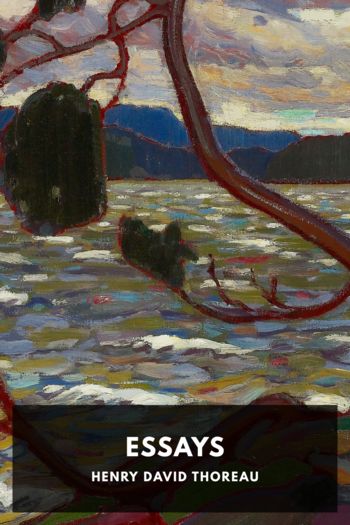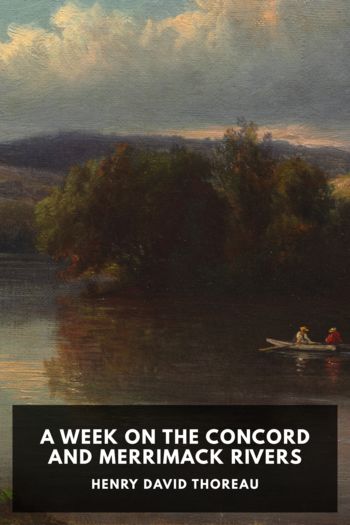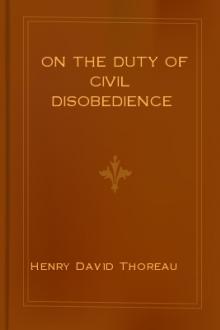Essays by Henry David Thoreau (feel good books .txt) 📕

Description
Though perhaps most famous for Walden, Henry David Thoreau was also a prolific essayist. Many of his essays touch on subjects similar to his famous book: long walks through nature, things found in moonlight that are invisible and unheard during the day, his preference for wild apples over domestic ones. In many ways he prefigured environmentalism, expressing his love for untouched nature and lamenting what the encroachment of man and cities were doing to it.
He also had strong opinions on many other subjects. One of his most famous essays, “On the Duty of Civil Disobedience,” was written as a result of his going to jail for refusing to pay several years’ worth of poll taxes. One of the primary reasons for his refusal was his holding the government in contempt for its support of slavery, and several of his other essays express support and admiration for John Brown, who thought to start a slave revolt when he attacked Harper’s Ferry in 1859.
Whether discussing trees in a forest, slavery, or the works of Thomas Carlyle, Thoreau’s essays are deeply personal and full of keen observations, often in poetic language. They give a sense of the man expressing them as being much more than the views being expressed.
Read free book «Essays by Henry David Thoreau (feel good books .txt) 📕» - read online or download for free at americanlibrarybooks.com
- Author: Henry David Thoreau
Read book online «Essays by Henry David Thoreau (feel good books .txt) 📕». Author - Henry David Thoreau
The tree is mentioned in at least three places in the Old Testament, and its fruit in two or three more. Solomon sings—“As the apple-tree among the trees of the wood, so is my beloved among the sons.” And again—“Stay me with flagons, comfort me with apples.” The noblest part of man’s noblest feature is named from this fruit, “the apple of the eye.”
The apple-tree is also mentioned by Homer and Herodotus. Ulysses saw in the glorious garden of Alcinous “pears and pomegranates, and apple-trees bearing beautiful fruit” (καὶ μηλέαι ἀγλαόκαρποι). And according to Homer, apples were among the fruits which Tantalus could not pluck, the wind ever blowing their boughs away from him. Theophrastus knew and described the apple-tree as a botanist.
According to the Prose Edda, “Iduna keeps in a box the apples which the gods, when they feel old age approaching, have only to taste of to become young again. It is in this manner that they will be kept in renovated youth until Ragnarök” (or the destruction of the gods).
I learn from Loudon that “the ancient Welsh bards were rewarded for excelling in song by the token of the apple-spray”; and “in the highlands of Scotland the apple-tree is the badge of the clan Lamont.”
The apple-tree (Pyrus malus) belongs chiefly to the northern temperate zone. Loudon says, that “it grows spontaneously in every part of Europe except the frigid zone, and throughout Western Asia, China, and Japan.” We have also two or three varieties of the apple indigenous in North America. The cultivated apple-tree was first introduced into this country by the earliest settlers, and is thought to do as well or better here than anywhere else. Probably some of the varieties which are now cultivated were first introduced into Britain by the Romans.
Pliny, adopting the distinction of Theophrastus, says—“Of trees there are some which are altogether wild (sylvestres), some more civilized (urbaniores).” Theophrastus includes the apple among the last; and, indeed, it is in this sense the most civilized of all trees. It is as harmless as a dove, as beautiful as a rose, and as valuable as flocks and herds. It has been longer cultivated than any other, and so is more humanized; and who knows but, like the dog, it will at length be no longer traceable to its wild original? It migrates with man, like the dog and horse and cow: first, perchance, from Greece to Italy, thence to England, thence to America; and our Western emigrant is still marching steadily toward the setting sun with the seeds of the apple in his pocket, or perhaps a few young trees strapped to his load. At least a million apple-trees are thus set farther westward this year than any cultivated ones grew last year. Consider how the Blossom-Week, like the Sabbath, is thus annually spreading over the prairies; for when man migrates, he carries with him not only his birds, quadrupeds, insects, vegetables, and his very sward, but his orchard also.
The leaves and tender twigs are an agreeable food to many domestic animals, as the cow, horse, sheep, and goat; and the fruit is sought after by the first, as well as by the hog. Thus there appears to have existed a natural alliance between these animals and this tree from the first. “The fruit of the crab in the forests of France,” is said to be “a great resource for the wild-boar.”
Not only the Indian, but many indigenous insects, birds, and quadrupeds, welcomed the apple-tree to these shores. The tent-caterpillar saddled her eggs on the very first twig that was formed, and it has since shared her affections with the wild cherry; and the cankerworm also in a measure abandoned the elm to feed on it. As it grew apace, the bluebird, robin, cherry-bird, kingbird, and many more, came with haste and built their nests and warbled in its boughs, and so became orchard-birds, and multiplied more than ever. It was an era in the history of their race. The downy woodpecker found such a savory morsel under its bark, that he perforated it in a ring quite round the tree, before he left it—a thing which he had never done before, to my knowledge. It did not take the partridge long to find out how sweet its buds were, and every winter eve she flew, and still flies, from the wood, to pluck them, much to the farmer’s sorrow. The rabbit, too, was not slow to learn the taste of its twigs and bark; and when the fruit was ripe, the squirrel half-rolled, half-carried it to his hole; and even the musquash crept up the bank from the brook at evening, and greedily devoured it, until he had worn a path in the grass there; and when it was frozen and thawed, the crow and the jay were glad to taste it occasionally. The owl crept into the first apple-tree that became hollow, and fairly hooted with delight, finding it just the place for him; so, settling down into it, he has remained there ever since.
My theme being the wild apple, I will merely glance at some of the seasons in the annual growth of the cultivated apple, and pass on to my special province.
The flowers of the apple are perhaps the most beautiful of any tree’s, so copious and so delicious to both sight and scent. The walker is frequently tempted to turn and linger near some more than usually handsome one, whose blossoms are two thirds expanded. How superior it is in these respects to the pear, whose blossoms are neither colored nor fragrant!
By the middle of July, green apples are so large as to remind us of coddling, and of the autumn. The sward is commonly strewed with little ones which fall stillborn, as it were—nature thus thinning them for us. The Roman writer Palladius said—“If apples are inclined to fall before





Comments (0)